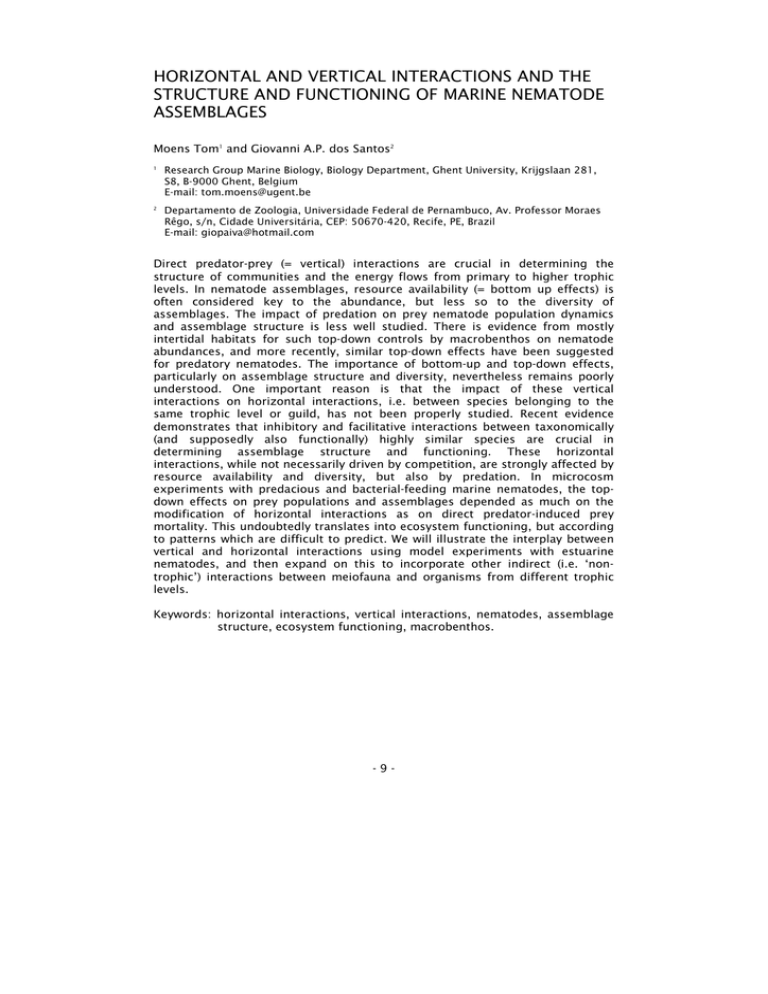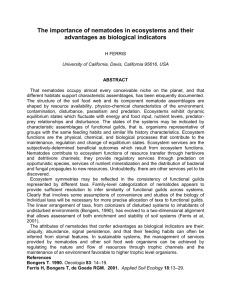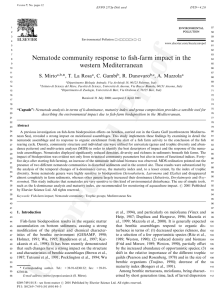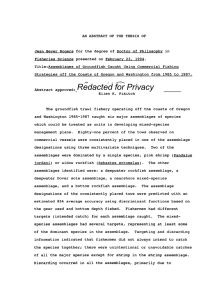HORIZONTAL AND VERTICAL INTERACTIONS AND THE ASSEMBLAGES Moens Tom
advertisement

HORIZONTAL AND VERTICAL INTERACTIONS AND THE STRUCTURE AND FUNCTIONING OF MARINE NEMATODE ASSEMBLAGES Moens Tom1 and Giovanni A.P. dos Santos2 1 Research Group Marine Biology, Biology Department, Ghent University, Krijgslaan 281, S8, B-9000 Ghent, Belgium E-mail: tom.moens@ugent.be 2 Departamento de Zoologia, Universidade Federal de Pernambuco, Av. Professor Moraes Rêgo, s/n, Cidade Universitária, CEP: 50670-420, Recife, PE, Brazil E-mail: giopaiva@hotmail.com Direct predator-prey (= vertical) interactions are crucial in determining the structure of communities and the energy flows from primary to higher trophic levels. In nematode assemblages, resource availability (= bottom up effects) is often considered key to the abundance, but less so to the diversity of assemblages. The impact of predation on prey nematode population dynamics and assemblage structure is less well studied. There is evidence from mostly intertidal habitats for such top-down controls by macrobenthos on nematode abundances, and more recently, similar top-down effects have been suggested for predatory nematodes. The importance of bottom-up and top-down effects, particularly on assemblage structure and diversity, nevertheless remains poorly understood. One important reason is that the impact of these vertical interactions on horizontal interactions, i.e. between species belonging to the same trophic level or guild, has not been properly studied. Recent evidence demonstrates that inhibitory and facilitative interactions between taxonomically (and supposedly also functionally) highly similar species are crucial in determining assemblage structure and functioning. These horizontal interactions, while not necessarily driven by competition, are strongly affected by resource availability and diversity, but also by predation. In microcosm experiments with predacious and bacterial-feeding marine nematodes, the topdown effects on prey populations and assemblages depended as much on the modification of horizontal interactions as on direct predator-induced prey mortality. This undoubtedly translates into ecosystem functioning, but according to patterns which are difficult to predict. We will illustrate the interplay between vertical and horizontal interactions using model experiments with estuarine nematodes, and then expand on this to incorporate other indirect (i.e. ‘nontrophic’) interactions between meiofauna and organisms from different trophic levels. Keywords: horizontal interactions, vertical interactions, nematodes, assemblage structure, ecosystem functioning, macrobenthos. -9-










